I have a UITableView that I am applying a set of filters on. The filters animate from below the navigation bar when I tap the "Filter" button. What I am doing here is taking a NIB that I loaded an adding it to the UITableView's superview. This works perfectly when I launch the view. I am able to show and hide the filter NIB. However, after the app has been sent to the background by hitting the home button, I then launch the app again to bring it into the foreground. Now the NIB that I loaded and attached to the superview of the UITableView has taken over the screen. The tableview is hidden beneath this view and I can see a small section of hit by hiding the filter NIB. Eventhough my NIB that I added to the superview has a height of 75, when it comes into the foreground I can see that its frame now has a size of over 400. Has anyone got any ideas as to why this could be happening to the superview? Thanks
My Code
- (IBAction)filterButtonPressed:(UIBarButtonItem *)sender
{
//If the filter view is displayed on screen then remove it.
if(self.filterViewDisplayed == YES){
[self animateFilterButtonsWithButtonsYOrigin:-75 tableViewYOrigin:-75];
self.filterViewDisplayed = NO;
}else {
//Determine if we should load the FilterButtons XIB
if(self.filterViewLoaded == NO) {
self.filterViewLoaded = YES;
[self.tableView.superview addSubview:self.activityFilter];
}
self.filterViewDisplayed = YES;
//Set the delegate of the ActivityFilter to self so that we can handle callbacks.
self.activityFilter.delegate = self;
//Set the intial frame of the filter buttons to be -75 pixels off the top of the screen
CGRect filterFrame = self.activityFilter.frame;
filterFrame.origin.y = -75;
self.activityFilter.frame = filterFrame;
//Now animate the filter buttons to appear at origin 0.
[self animateFilterButtonsWithButtonsYOrigin:0 tableViewYOrigin:75];
}
}
- (void)animateFilterButtonsWithButtonsYOrigin:(CGFloat)yOrigin tableViewYOrigin:(CGFloat)tableViewYOrigin
{
[UIView animateWithDuration:0.25
animations:^{
CGRect filterFrame = self.activityFilter.frame;
filterFrame.origin.y = yOrigin;
self.activityFilter.frame = filterFrame;
[self adjustTableViewOriginBy:tableViewYOrigin];
}];
}
-(void)adjustTableViewOriginBy:(CGFloat)yOrigin
{
CGRect tableFrame = self.tableView.frame;
tableFrame.origin.y += yOrigin;
self.tableView.frame = tableFrame;
}
Screenshots
- Before Filter animation
- After filter applied
- After launching from background - PROBLEM here. Superview takes up entire view
- Hiding filter reveals tableview beneath the superview



